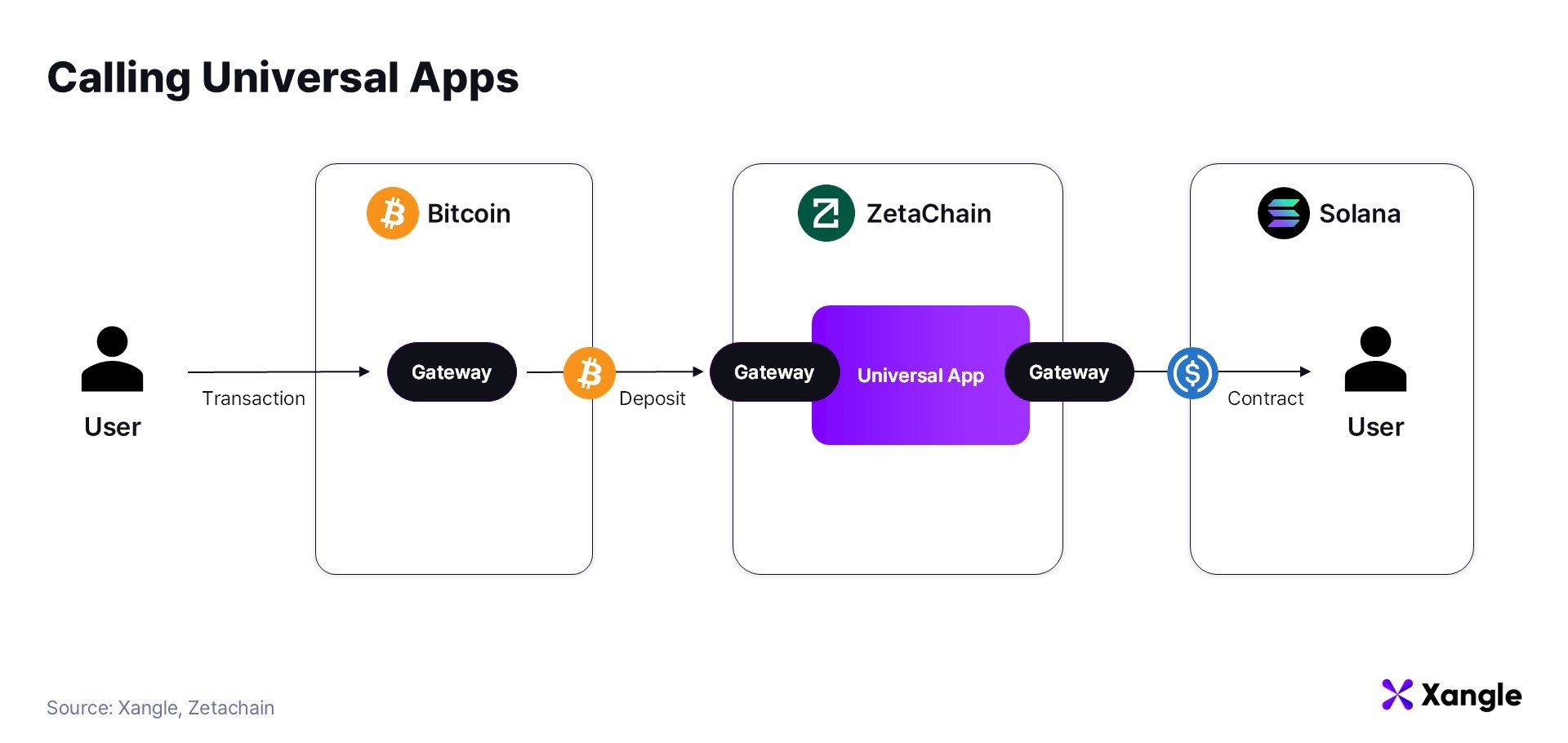


Table of Contents
1. Project Overview
2. 1Q25 Key Highlights
2-1. Integration with TON and Sui – Expanding into an omnichain network covering diverse L1s
2-2. Rapid expansion of the universal apps ecosystem
2-3. ZetaChain seeks to establish a presence in the rapidly growing Bitcoin ecosystem
2-4. Enhancing network performance and stability with global infrastructure companies joining as validators
3. On-Chain Performance – A Shift Towards Positive Network Activity
4. Closing Summary – 1Q25 Marks a Turning Point for Ecosystem Expansion
1. Project Overview
ZetaChain is a Proof-of-Stake (PoS) blockchain network built on the Cosmos SDK and Tendermint PBFT consensus algorithm, providing fast block generation speeds under 5 seconds with immediate finality.
Designed as an omnichain network, ZetaChain supports interactions across multiple blockchains. It leverages its proprietary execution layer, zEVM, which includes built-in omnichain smart contracts, enabling innovative functionalities to interconnect multiple chains. Key components of the ZetaChain network include Validators that maintain security and ensure data integrity, Observers that verify the state of external chains, and TSS Signers responsible for signing external messages. For further details about ZetaChain, please refer to Xangle’s “ZetaChain: Navigating Chain Abstraction with Native Bitcoin”.
2. 1Q25 Key Highlights
2-1. Integration with TON and Sui – Expanding into an omnichain network covering diverse L1s
In 1Q25, ZetaChain significantly expanded its ecosystem beyond EVM-compatible chains by officially announcing integrations with Sui and TON. Previously, ZetaChain had validated the robustness and stability of its cross-chain capabilities through successful integrations with Ethereum, Bitcoin, Solana, BNB, and Polygon. This recent announcement represents yet another critical milestone in ZetaChain’s ongoing strategic roadmap towards comprehensive blockchain interoperability.
TON and Sui, both distinguished by substantial user bases and high levels of technological sophistication, have generated considerable anticipation around their integration with ZetaChain. TON, a blockchain network closely linked with the messaging platform Telegram, demonstrated a robust real-world user base, surpassing 2.2 million daily active wallets in September 2024. However, this figure has recently decreased to an average of approximately 150,000 wallets. On the other hand, Sui, leveraging the performance-focused Move programming language, has established itself as a prominent network, achieving approximately 2.5 million daily active wallets and around 66 million daily transactions. Additionally, Sui maintains substantial liquidity, reflected by an over eightfold increase in its TVL throughout 2024, reaching $1.43 billion as of April 17, 2025.
Integrating TON (TVM) and Sui (MoveVM)—chains operating on fundamentally different virtual machine architectures—presented significant technical challenges. Nevertheless, ZetaChain successfully navigated these complexities by abstracting inter-chain message passing and asset transfers through its proprietary standardized protocols, thereby simplifying multi-chain connectivity.
Specifically, the integration with TON leverages the native TVM-based messaging structure. When transaction messages originating from TON reach ZetaChain’s Gateway smart contract on the TON blockchain, they are seamlessly converted into an EVM-compatible format for processing. Transactions from Sui undergo an analogous process: upon arriving at the Gateway, ZetaChain interprets and processes them similarly using its standardized EVM-based mechanisms. By systematically standardizing the handling of messages and transactions originating from distinct chains, ZetaChain has successfully implemented a universal cross-chain execution environment capable of supporting various virtual machine architectures such as TVM and MoveVM.
Ultimately, this recent integration transcends the mere addition of new blockchains. It exemplifies ZetaChain's evolution into a genuine omnichain network capable of bridging diverse VM environments and extensive real-world user bases. Through such expansions, ZetaChain is expected to attract a broader demographic of users and developers, making significant strides toward its vision of enabling true chain abstraction and fostering the flexible design of decentralized applications within a universally compatible execution environment.
2-2. Rapid expansion of the universal apps ecosystem
ZetaChain’s Universal App infrastructure is purpose-built for a multi-chain environment. Through its innovative Universal Smart Contract framework, ZetaChain enables a single smart contract to seamlessly handle calls originating from multiple blockchains and subsequently relay instructions back across various chains. This approach eliminates traditionally cumbersome tasks such as cross-chain bridging, wallet switching, and multiple fee payments, providing users with a streamlined, "one-click" experience to execute functionalities across diverse blockchain ecosystems.

Recently, significant universal applications have been launched within the ZetaChain ecosystem, supported by the promotional "Universal App Season 1" campaign. Conducted over approximately four weeks starting from mid-February 2025. Importantly, this initiative went beyond technical demonstrations by delivering practical, user-centric experiences, effectively highlighting ZetaChain’s superior UX capabilities. During this period, weekly active users exceeded 300,000, and ZetaHub notably ranked among the Top 10 popular DeFi apps on DappRadar. Key universal apps introduced in Season 1 include:
- Dust.fun: Consolidates small asset amounts from various chains into BTC or USDC through ZetaChain’s cross-chain swaps in a single transaction.
- Upcade: A gaming hub supporting various games across multiple chains, managing game records and rewards through ZetaChain.
- Pitch Lucy: An AI-driven investment gaming app where users propose investment ideas; the AI evaluates and purchases tokens accordingly, rewarding users whose ideas are adopted.
- Amana: A DeFi yield aggregator allowing users to deposit assets into networks and protocols offering the highest yields.
Universal apps integrate diverse blockchain assets and functionalities into a unified application environment, reducing entry barriers for new users and delivering an intuitive multi-chain UX. It is anticipated that this foundation will encourage the emergence of killer apps, ultimately helping ZetaChain fulfill its vision of becoming the “TCP/IP of blockchain.”
2-3. ZetaChain seeks to establish a presence in the rapidly growing Bitcoin ecosystem
As previously highlighted in our ZetaChain 4Q24 Review, ZetaChain has continued its agile expansion within the Bitcoin ecosystem. By forming strategic partnerships with prominent projects such as BitSmiley and Avalon Finance, ZetaChain has effectively established the infrastructure necessary to utilize native Bitcoin without relying on wrapping or bridging. These efforts underscore ZetaChain’s strategic vision of simplifying traditional cross-chain complexities to achieve genuine interoperability for native assets.
In 1Q25, this strategic approach began to materialize through concrete use cases. Universal apps enabling direct utilization of Bitcoin have been launched on the ZetaChain platform, marking a pivotal turning point for practical ecosystem expansion. For instance, BitSmiley allows users to deposit native BTC and mint bitUSD, subsequently enabling usage across various DeFi protocols on Ethereum and BNB Chain. Additionally, diverse universal apps such as Beam (cross-chain swaps between Bitcoin and other blockchains), Vertikals (a multi-chain NFT marketplace), and SubstanceX (derivatives trading platform based on native BTC) have emerged, significantly enriching the cross-chain user experience centered around Bitcoin.
The Bitcoin ecosystem is currently expanding faster than ever before. The TVL in Bitcoin, which stood around $340M as of January 1, 2024, has soared dramatically to surpass $3.7B, marking an approximate increase of 1,100%. This growth goes beyond mere price appreciation, indicating a structural expansion across DeFi, NFTs, and broader infrastructure ecosystems centered around Bitcoin. ZetaChain, positioned within this growth trajectory, is solidifying its unique presence through universal apps based on native Bitcoin. As the Bitcoin ecosystem continues to expand, ZetaChain’s role and influence within this space are expected to grow accordingly.
2-4. Enhancing network performance and stability with global infrastructure companies joining as validators
Throughout Q1, ZetaChain secured successive partnerships with global infrastructure companies, substantially boosting network reliability and scalability. Notably, Deutsche Telekom MMS, Alibaba Cloud, and Japan’s NTT Digital joined ZetaChain as validators.
- Deutsche Telekom MMS: A subsidiary of Deutsche Telekom, Germany's largest telecommunications provider, Deutsche Telekom MMS has extensive experience validating for public blockchains such as Ethereum, Polkadot, and Polygon. Recently joining ZetaChain as an official validator, the company leverages its Open Telekom Cloud (OTC) infrastructure stack to facilitate stable node operations. This partnership is considered a key milestone enhancing network stability and security within the European region and accelerating global Web3 adoption.
- Alibaba Cloud: Asia’s largest cloud computing provider, Alibaba Cloud enhances ZetaChain's decentralization and scalability by supplying robust infrastructure. It supports universal app development in a multi-chain environment, offering ZetaChain developers various support programs including cloud credits, access to a global funding network, and technical consultations.
- NTT Digital: A Web3-focused subsidiary of Japan’s largest telecommunications firm, NTT Group, NTT Digital actively participates in blockchain infrastructure under the global NTT Docomo Group. Following its validator participation in Injective in 2024, NTT Digital recently joined ZetaChain as an official validator, further reinforcing the network’s decentralization and scalability. NTT Digital’s involvement is anticipated to accelerate the adoption of ZetaChain's omnichain technology across various sectors, including mobility, finance, and IoT, facilitating Web3 interoperability implementation in Japan and global markets.
As of April 18, ZetaChain has 176 active validators operating its network, with the largest validator holding a mere 7.59% stake. This clearly demonstrates ZetaChain’s already decentralized architecture. Coupled with strategic partnerships with global infrastructure providers, ZetaChain is well-positioned to achieve heightened network performance and stability.
3. On-Chain Performance – A Shift Towards Positive Network Activity

Since launching its mainnet beta in January 2024, ZetaChain has rapidly expanded in terms of both on-chain metrics and community growth. According to DappRadar, ZetaChain ranks 10th among all Layer 1 networks in weekly active users. The cumulative number of wallets has surpassed 4.17 million, and cumulative transactions have exceeded 166 million. Additionally, over 42,000 dApp contracts have been deployed, and more than 300 ecosystem partners have joined forces with ZetaChain. Notably, the number of dApp contracts, which stood at approximately 18,500 at the end of 2024, surged by more than 120% in just a few months, clearly demonstrating rapid ecosystem expansion.
On-chain metrics for Q1 showed a positive trend. Transaction volume increased by 18% compared to the previous quarter, while daily active users remained stable, showing a modest 1% growth. However, it is particularly meaningful that the upward trend in on-chain activity intensified towards the end of Q1 and has continued to persist as of April 21, the time of writing. The primary driver behind this increase in transaction volume was heightened activity within ZetaHub due to the launch of several prominent dApps in the ZetaChain ecosystem. ZetaHub serves as the ecosystem hub for ZetaChain, offering features like loyalty programs, staking, asset transfers, and data monitoring. Currently, ZetaHub is running an "Instant Rewards" program that allows users to instantly claim rewards upon completing quests. Unlike short-term user surges commonly induced by traditional airdrop incentive programs, the Instant Rewards program seems to encourage sustained user engagement. Although Instant Rewards existed last quarter as well, higher participation this quarter is attributed to the richer variety of on-chain activities resulting from newly launched applications.
Global education initiatives and strengthened community bases have also positively influenced on-chain metrics. In March, ZetaChain collaborated with Coinbase on a Learning Rewards campaign, providing ZETA tokens as incentives upon completion of simple quests. The campaign attracted over 500,000 participants, with approximately 200,000 new users actively trying out ZETA staking services.
4. Closing Summary – 1Q25 Marks a Turning Point for Ecosystem Expansion
Historically, ZetaChain has showcased a high degree of technical maturity but experienced relatively limited growth regarding on-chain utility and overall ecosystem scale. Particularly in the early phases of the mainnet, despite robust architectural design and technical sophistication, user acquisition and dApp expansion progressed slowly. However, the first quarter of 2025 marks a clear turning point in ZetaChain’s path toward significant ecosystem expansion.
By successfully integrating non-EVM chains such as TON and Sui, ZetaChain demonstrated its technical scalability and solidified its foundation for attracting substantial user bases and liquidity. Additionally, the visible growth of the Universal App ecosystem and the agile entry into the rapidly expanding Bitcoin ecosystem provided concrete examples of practical ecosystem expansion. The onboarding of global infrastructure companies as validators, along with strategies such as Learning Rewards and the Ambassador Program, have further strengthened ZetaChain’s foundation for user growth.
While certain metrics like TVL and daily active users still require improvement, ZetaChain appears to be quickly assembling the necessary pieces for sustained growth. Going forward, continuous monitoring will be essential to observe if ZetaChain can steadily maintain this momentum and realize its vision as an "omnichain platform encompassing all chains." With high expectations, we conclude this report anticipating that Q1 2025 will indeed become a pivotal turning point for ZetaChain's ecosystem expansion.


